Inshore Fisheries Research Section
Red Drum - Hooks
This study has found that non-offset CIRCLE HOOKS lip hook red drum over 90% of the time. Significatly more red drum are released alive when caught on non-offset CIRCLE HOOKS than on J-hooks or offset circle hooks.
In this Study, we used:
- For Sub-Adult Red Drum in Shallow Water: Eagle Claw L702G-4/0 Circle Hooks
- For Adult Red Drum in Deep Water: Eagle Claw L200ELF 9/0 Circle Hooks
This project was funded by a grant from the Cooperative Research Program of the National Marine Fisheries Service Southeast Regional Office.
J-Hooks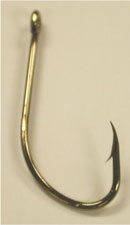 |
J-hooks are the type of hook traditionally used for fishing with natural bait. When fishing with a J-hook, the angler "sets" the hook by jerking up on the rod when he feels a bite. If the fish eats by inhaling its entire prey, this may cause the fish to be hooked in the esophagus or gut. Red drum tend to swallow their prey quickly in a vacuum-type motion. Studies in other states have shown that J-hooks have a tendency to deep-hook fish with this type of eating habit. One study in North Carolina (Aguilar et al. 2002) showed that 52.27% of adult red drum (880-1250 mm Fork Length) were deep-hooked in the throat or gut. Of these, 16.28% died of their injuries within 3 days. However, none of the fish that were caught in the mouth or tongue died of injuries within the 3 days monitoring period. In our study, 35-40% of red drum were gut-hooked using J-hooks and 5-11% died of their injuries within 48 hours. |
|
Circle Hooks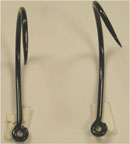 |
Circle hooks are defined by the Atlantic States Marine Fisheries Commission as "a non-offset hook with the point turned perpendicularly back to the shank." These are also known as non-offset circle hooks. There are also hooks available today which have the basic circle shape, but the point is NOT in line with the shank. These are known as offset circle hooks. Fishing with a circle hook is somewhat different from fishing with a J-hook and experienced anglers may have a hard time getting used to them. Instead of "setting" the hook by jerking the rod, the angler must apply steady pressure to the line, bringing it in slowly but steadily. If the angler jerks the rod to set the hook, the hook will often pull out of the fish's mouth and the angler will lose the fish. |
|
| Non-offset Circle Hooks 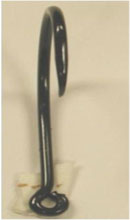 |
Non-offset Circle Hooks have been standard gear in the commercial longline fishery for the past 20 years. Their use has spread to many recreational fisheries as well. In the sailfish catch-and-release fishery, it was found that circle hooks and J-hooks displayed similar catch rates, but that 98% of fish were caught in the jaw with circle hooks. Only 2% were deep-hooked (Prince et al. 2002). The North Carolina Study mentioned above (Aguilar et al. 2002) found that only 1 out of 24 red drum caught on non-offset circle hooks was hooked in the gut. The other 23 were hooked in the jaw. They also found 0% mortality for circle hooks. Our study has shown that only 5-10% of red drum are hooked in the gut using non-offset circle hooks, and 2-5% die of these injuries. |
|
Offset Circle Hooks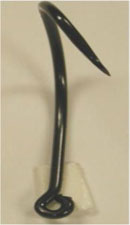 |
Offset circle hooks are similar in shape to the non-offset circle hook; however, the point is not in line with the shank. Hooks are often offset because people believe that this will increase the efectiveness of the hook. However, there is anecdotal evidence that offsetting a circle hook actually decreases its effectiveness and increases the amount of deep hooking over non-offset circle hooks. Our study shows the deep-hooking rate of offset circle hooks is 23%, (intermediate between J-hooks and circle hooks) but that mortality is similar to that of J-hooks (10%). |
|
Treble Hook 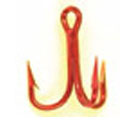 |
Treble hooks are three-pronged hooks used often on artificial lures. This type of hook had been thought to cause higher mortality than J-hooks in the past. However, it has been shown in several studies that treble hooks cause a comparable amount of mortality to J-hooks. Very similar results have been obtained in studies in both Texas and Alabama (Matlock et al. 1993, Duff 2002). If a fish is deep-hooked with a treble hook, there is a high mortality rate. However, if artificial baits are used, fish are not deep-hooked very often (Muoneke & Childress 1994). |
|
Kahle Hook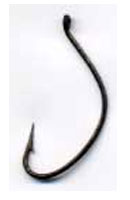 |
Kahle hooks and circle hooks look similar, but there is a subtle difference in shape. In kahle hooks, the barb is pointed toward the hook eye instead of toward the shank of the hook. The distance is also much greater between the point and the shaft. This may lead to an increased rate of gut-hooking. Kahle hooks are efficient at catching fish, but they may contribute to a high mortality rate once the fish is released. To date no research has been aimed at Kahle hooks. These hooks need to be studied since they are gaining popularity among red drum anglers. |
|
Literature Cited:
Aguilar R, Rand PS, Beckwith GH. 2002. Quantifying the catch-and-release mortality rate of adult red drum in the Neuse River Estuary. Final Report (01-FEG-07) North Carolina Fisheries Resource Grant Program.
Duff J. 2002. Catch-and-release mortality studies of spotted sea trout and red drum in coastal Alabama. American Fisheries Society Symposium 30:110-113.
Matlock GC, McGachron LW, Daily JA, Unger PA, Chai P. 1993. Short-term hooking mortalities of red drums and spotted seatrout caught on single-barb and treble hooks. North American Journal of Fisheries Management 13: 186-189.
Muoneke MI, Childress WM. 1994. Hooking mortality: a review for recreational fisheries. Reviews in Fisheries Science 2: 123-156.
Prince ED, Ortiz M, Venizelos A. 2002. A comparison of circle hook and "J" hook performance in recreational catch-and-release fisheries for billfish. American Fisheries Society Symposium 30:66-79.
This project was funded by a grant from the Cooperative Research Program of the National Marine Fisheries Service Southeast Regional Office.
